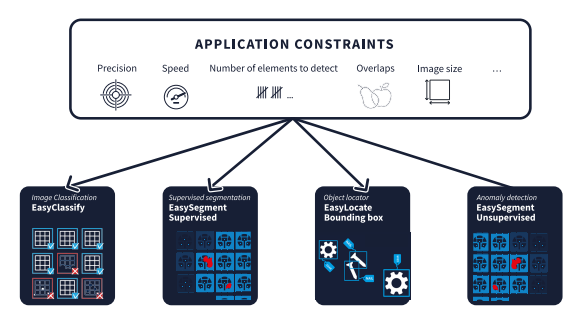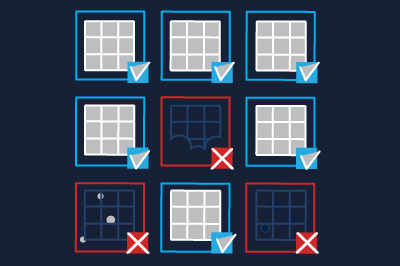Euresys Deep Learning Bundle, a suite of powerful image analysis libraries
Product /
07.2023
Euresys has been on a journey for a number of years, producing some of the most powerful image analysis libraries and software tools, recognized throughout the machine vision industry.
The Deep Learning Bundle is the latest development that completes a range of image processing libraries in regular use with an extensive customer base, mostly machine manufacturers who supply the semiconductor and electronics industries.

The Deep Learning libraries consist of software tools responding to three specific functions for which Deep Learning provides a solution: classification, segmentation and localization. They are part of the Open eVision Deep Learning Bundle, which can be used with the free Deep Learning Studio training and evaluation application.
But What is Deep Learning?
Neural Networks are computing systems inspired by the biological neural networks that constitute the human brain. Convolutional Neural Networks (CNN) are a class of deep, feed-forward artificial neural networks, most commonly applied to analyzing images. Deep Learning uses large CNNs to solve complex problems difficult or impossible to solve with so-called conventional computer vision algorithms. Deep Learning algorithms may be easier to use as they typically learn by example. They do not require the user to figure out how to classify or inspect parts. Instead, in an initial training phase, they learn just by being shown many images of the parts to be inspected. After successful training, they can be used to classify parts, or detect and segment defects.
Classification
 EasyClassify is the classification tool of Deep Learning Bundle. EasyClassify is a library for the classification of images, that is used for defect detection and product recognition. EasyClassify requires the user to label training images, that is to tell which ones are good and which ones are bad, or which ones belong to which class. After this learning/training process, the EasyClassify library is able to classify images. For any given image, it returns a list of probabilities, showing the likelihood that the image belongs to each of the classes it has been taught. For example, if the process requires setting apart bad parts from good ones, EasyClassify returns whether each part is good or bad, and with what probability.
EasyClassify is the classification tool of Deep Learning Bundle. EasyClassify is a library for the classification of images, that is used for defect detection and product recognition. EasyClassify requires the user to label training images, that is to tell which ones are good and which ones are bad, or which ones belong to which class. After this learning/training process, the EasyClassify library is able to classify images. For any given image, it returns a list of probabilities, showing the likelihood that the image belongs to each of the classes it has been taught. For example, if the process requires setting apart bad parts from good ones, EasyClassify returns whether each part is good or bad, and with what probability.
Segmentation
 EasySegment is the segmentation tool of Deep Learning Bundle designed to ease the process of segmenting objects and defects. It identifies parts that contain defects, and precisely pinpoints where they are in the image. The supervised mode of EasySegment works by learning a model of what is a defect and what is a “good” part in an image. This is done by training with images annotated with the expected segmentation. Then, the tool can be used to detect and segment the defects in new images. The supervised mode of EasySegment achieves better precision and can segment more complex defects than the unsupervised mode thanks to the knowledge of the expected segmentation. The unsupervised mode of EasySegment works by learning a model of what is a “good” sample (i.e. a sample without any defect). This is done by training it only with images of “good” samples. Then, the tool can be used to classify new images as good or defective and segment the defects from these images. By training only with images of good samples, the unsupervised mode of EasySegment is able to perform inspection even when the type of defect is not known beforehand or when defective samples are not readily available.
EasySegment is the segmentation tool of Deep Learning Bundle designed to ease the process of segmenting objects and defects. It identifies parts that contain defects, and precisely pinpoints where they are in the image. The supervised mode of EasySegment works by learning a model of what is a defect and what is a “good” part in an image. This is done by training with images annotated with the expected segmentation. Then, the tool can be used to detect and segment the defects in new images. The supervised mode of EasySegment achieves better precision and can segment more complex defects than the unsupervised mode thanks to the knowledge of the expected segmentation. The unsupervised mode of EasySegment works by learning a model of what is a “good” sample (i.e. a sample without any defect). This is done by training it only with images of “good” samples. Then, the tool can be used to classify new images as good or defective and segment the defects from these images. By training only with images of good samples, the unsupervised mode of EasySegment is able to perform inspection even when the type of defect is not known beforehand or when defective samples are not readily available.
Localization
 EasyLocate is the localization and identification library of Deep Learning Bundle. It is used to locate and identify objects, products, or defects in the image. It has the capability of distinguishing overlapping objects and, as such, EasyLocate is suitable for counting the number of object instances.
EasyLocate is the localization and identification library of Deep Learning Bundle. It is used to locate and identify objects, products, or defects in the image. It has the capability of distinguishing overlapping objects and, as such, EasyLocate is suitable for counting the number of object instances.
Two methods are available:
“EasyLocate Axis Aligned Bounding Box” predicts the bounding box surrounding each object (or defect) it has found in the image and assigns a class label to each of them. It must be trained with images where the objects (or defects) that must be found have been annotated with a bounding box and a class label.
“EasyLocate Interest Point” predicts the position (as one point, typically the center, but may be otherwise defined) for each object (or defect) it has found in the image and assigns a class label to each of them. All the objects (or defects) in the image must have the same approximate size. It must be trained with images where the objects (or defects) that must be found have simply been annotated with an interest point and a class label. The annotation process is faster with EasyLocate Interest Point as a single click is enough to annotate an object.
Free Evaluation: Open eVision Deep Learning Studio
The Deep Learning Studio is an application that assists the user during the creation of the dataset as well as the training and testing of the Deep Learning tools of Open eVision. It is free and does not require any license. It allows users to test the Deep Learning libraries using their own images. It can be downloaded from the Euresys website. Sample images, manuals and example programs are included and no programming is required.
Testimonial

" What I really appreciate is that the Deep Learning Studio is free to download from Euresys website and that no license is needed. This allowed me to evaluate the performance of the eVision tools with my actual images, solving any potential confidentiality issue. "